#ugaritic gods
Text
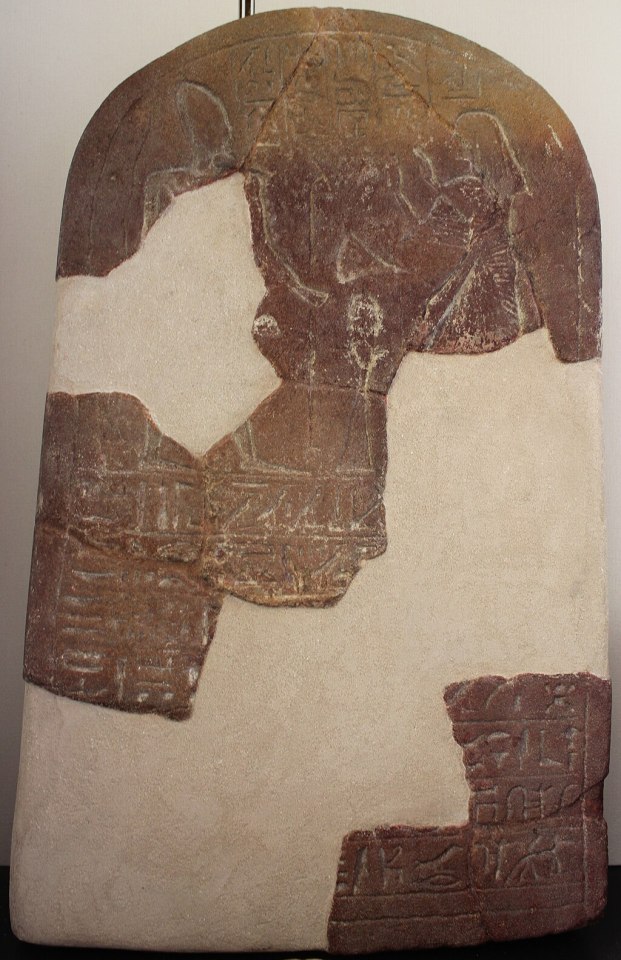
Stele of Set Sapouna (Baal Zephon)
c. 1350 BCE
Rash Shamra, Ugarit (modern Syria)
Louvre Museum AO13176
A dedicatory stele by Maymi, the royal scribe, and former supervisor of the treasury, identifying the mountain/storm god Baal Zephon (Baalu Sapunu) with the Egyptian deity Set (Sutekh). Found within the temple of Baal-Hadad in Ugarit.
#baal#baal hadad#hadad#adad#beelzephon#set#seth#set deity#sutekh#canaan#canaanite gods#phoenicia#phoenician gods#aram#aramean gods#syria#syrian gods#levantine gods#hellenismos#mesopotamia#mesopotamian gods#ugarit#ugaritic gods#egypt#egyptian gods#kemeticism#kemetic#kemetic polytheism
24 notes
·
View notes
Text
academic writing is starting out w one thesis and landing somewhere totally different
#somehow I've written like 13 pages so far abt what deities and stories were absorbed into the mythology of god#that wasn't the intent it was just going to be a look at the connections between the ugaritic texts and the tanakh but well. here we are.#capstone of my entire BA being the thesis that God is made up of 2 goddesses and 2 gods.#he's slaying in a bigender manner or whatever#actually more than that bc this is just the ugaritic texts but you can find other gods that got absorbed into god from other nearby#or more ancient traditions#which to Me is very lovely and kind of poetic but that's on a personal spiritual belief note#(not the historical absorption being lovely but rather the spiritual idea that god IS every god. one that has always appealed to me)
43 notes
·
View notes
Text
I’m working so hard on this illustration rn I spent an hour carefully drawing patterns from Syrian ivory carvings onto an aureole but it’s two different shades of gold so it looks really mild lmaoooooo
#I’ve been researching Ashtart and so of course I’m drawing and designing her#This current piece is based more on later sexuality depictions but I will be making an earlier Ugarit/emar style warlike piece at some poin#Also these sphinx/cherubim were so hard to do wth#Me when war cool god: I am going to give them so many scars <3
0 notes
Text
Melchizedek

View On WordPress
#Bible#Dead Sea Scrolls#Events#Freemasonry#gNOSTIC#God#Jesus#Melchizedek#Messianic#Mystical#Symbolism#Theological#Theophqany#Ugaritic mythology#Ugaritic texts
1 note
·
View note
Text
thinking about מֲלְאָךְ. it's often translated, in the hebrew bible, as 'angel.' but a more tight fit is something like 'here god is again.' the word comes from a ugaritic cognate—l’ak—which in the d tense (mu- prefixed) means 'to be sending and sent, constantly, repeatedly, dully,' dully. dully. angels coming and going, god theophanizing here, in this body, in another, in a bush now. the referent of 'מֲלְאָךְ' is the banality with which god enters his own bible, or, better yet, just a single affective shrug: 'what does he want, now?'
269 notes
·
View notes
Text
@thatlittleegyptologist and @somecunttookmyurl do y’all know why the Egyptian alef had to be an unrendered special character instead of a, ’, or god forbid apparently א? It’s an alef. Even if we don’t render the hieroglyphs why do we still not transliterate it in a way that can more easily be read? If we’re going to transliterate in Roman letters and if, to an extent, Semitic languages existed on a continuum with Egyptian, why not use a or, as with Phoenician and Ugaritic, use א?
109 notes
·
View notes
Text
💫Mythical Astrology💫
A collection of gods and goddesses associated with each sign~ Before you say something, yes! I AM aware that some of these deities are the same entity with different names. I wanted to include all names so readers could recognize the ones they knew :) Talk to me niiiiiiiiiiiiiiiice
Aries
Amun (Egyptian), Anat (Mesopotamian/Ugaritic/Egyptian), Ares (Greek), Badb (Irish), Belenus (Celtic), Cybele (Anatolian), Durga (Hindu), Hecate (Greek), Hestia (Greek), Indra (Hindu), Ishtar (Mesopotamian), Khnum (Egyptian), Macha (Irish), Marduk (Babylonian), Mars (Roman), Minerva (Roman), The Morrigan (Irish Celtic), Nergal (Mesopotamian), Ra (Egyptian), Sekhmet (Egyptian), Tiamat (Babylonian)
Taurus
Aphrodite (Greek), Asherah (Semitic), Astarte (Middle Eastern), Ba'al (Canaanite), Bacchus (Greco-Roman), Bast (Egyptian), Cernunnos (Celtic), Dionysus (Greek), Flora (Roman), Frigg (Norse), Gaia (Greek), Hathor (Egyptian), Horus (Egyptian), Indra (Hindu), Ishtar (Mesopotamian), Isis (Egyptian), Jupiter (Roman), Krishna (Hindu), Lakshmi (Hindu), Maia (Greek), Marduk (Babylonian), Mithra (Iranian), Osiris (Egyptian), Poseidon (Greek), Ptah (Egyptian), Venus (Roman), Zeus (Greek)
Gemini
Apollo (Greek), Artemis (Greek), Dumuzid (Sumerian), Enki (Sumerian), Hermes (Greek), Inanna (Mesopotamian), Janus (Roman), Krishna (Hindu), Mercury (Roman), Odin (Norse), Seshat (Egyptian), Thoth (Egyptian)
Cancer
Artemis (Greek), Ceres (Roman), Demeter (Greek), Diana (Roman), Isis (Egyptian), Juno (Roman), Kuan Yin (Chinese/Buddhist), Luna (Roman), Mercury (Roman)
Leo
Amun (Egyptian), Anat (Mesopotamian/Ugaritic/Egyptian), Bast (Egyptian), Cybele (Anatolian), Devi (Hindu), Diana (Roman), Durga (Hindu), Freyja (Norse), Hathor (Egyptian), Helios (Greek), Hera (Greek), Inanna (Mesopotamian), Ishtar (Mesopotamian), Juno (Roman), Mithra (Iranian), Nanna (Mesopotamian), Nergal (Mesopotamian), Ra (Egyptian), Sekhmet (Egyptian), Vishnu (Hindu)
Virgo
Anat (Mesopotamian/Ugaritic/Egyptian), Artemis (Greek), Demeter (Greek), Diana (Roman), Hestia (Greek), Inanna (Mesopotamian), Iris (Greek), Ishtar (Mesopotamian), Isis (Egyptian), Kore (Greek), Nanna (Mesopotamian), Odin (Norse), Persephone (Greek), Vesta (Roman)
Libra
Aphrodite (Greek), Athena (Greek), Cernunnos (Celtic), Frigg (Norse), Hephaestus (Greek), Isis (Egyptian), Justitia (Roman), Ma'at (Egyptian), Minerva (Roman), Mithra (Iranian), Nemesis (Greek), Njord (Norse), Shiva (Hindu), Thoth (Egyptian), Venus (Roman), Vishnu (Hindu)
Scorpio
Anubis (Egyptian), Ereshkigal (Mesopotamian), Hecate (Greek), Hel (Norse), Isis (Egyptian), Mars (Roman), Njord (Norse), Osiris (Egyptian), Persephone (Greek), Pluto (Roman), Set (Egyptian)
Sagittarius
Anat (Mesopotamian/Ugaritic/Egyptian), Artemis (Greek), Athena (Greek), Diana (Roman), Epona (Gallo-Roman), Hades (Greek), Isis (Egyptian), Jupiter (Roman), Mars (Roman), Nergal (Mesopotamian), Rhiannon (Welsh), Thor (Norse)
Capricorn
Agni (Hindu), Aphrodite (Greek), Ba'al (Canaanite), Dionysus (Greek), Ea (Babylonian), Enki (Sumerian), Faunus (Roman), Freyja (Norse), Freyr (Norse), Gaia (Greek), Hecate (Greek), Juno (Roman), Loki (Norse), Pan (Greek), Perun (Slavic), Saturn (Roman), Thor (Norse)
Aquarius
Astarte (Middle Eastern), Ea (Babylonian), Ishtar (Mesopotamian), Isis (Egyptian), Juno (Roman), Nut (Egyptian)
Pisces
Aegir (Norse), Aphrodite (Greek), Cupid (Roman), Diana (Roman), Ea (Babylonian), Enki (Sumerian), Eros (Greek), Neptune (Roman), Poseidon (Greek), Sedna (Inuit), Venus (Roman), Vishnu (Hindu)
#mythology#astrology#deities#gods#goddesses#associations#correspondences#egyptian#mesopotamian#greek#roman#celtic#norse#hindu
99 notes
·
View notes
Text

https://displate.com/ immagine
Testo: Leviathan: the origins of the myth(https://www.esquire.com/it/)
Tracing the origins of Leviathan is an extremely difficult task, since its first suggestions must probably be sought in ancient populations, in possible contact with large marine creatures that imagination and millennia have slowly transformed into indomitable aquatic monsters capable of instilling great terror in Man: after all, traces of snakes that inhabit the depths of the abyss can be found iconographically and narratively in the most disparate cultures such as for example in the Middle East (the story of the fight between Marduk and the serpent goddess Tiamat is very famous) or even the Norse mythology, where the dangerous Jörmungandr is defeated by none other than Thor. But to get to talking about the biblical Leviathan we must pass through Syria and precisely through Ugarit, the ancient capital city of the kingdom of the same name which no longer exists today: in this distant place which looks directly onto the Mediterranean Sea, the myth of the sea serpent which became then Leviathan. His original name, however, is Lôtān and he is one of the servants of the God of the Sea Yammu who is defeated by Hadad in one of the most famous passages of the Baal Cycle: at this point in our research, however, a translation problem arises which makes it difficult to understand who some epithets contained in the text refer to and consequently what characteristics Lôtān has, sometimes described as a slithering serpent or as a powerful monster with 7 heads.(https://www.esquire.com/it/)
Tiamat mother abyss
#witchcraft#witch#witches#occultism#luciferian witch#satanist#satanism#theistic satanism#theistic satanist#hail lucifer#luciferism#lefthandpath#tiamat#darkgodess#dark mother#leviatan#hail satan#theistic luciferianism#esoterism#esoteric#dark#dark aesthetic#dark art#satan#satanic witch#ritual magic#satanic#ave satanas#satanismo#occult
32 notes
·
View notes
Text
So how did we get from this
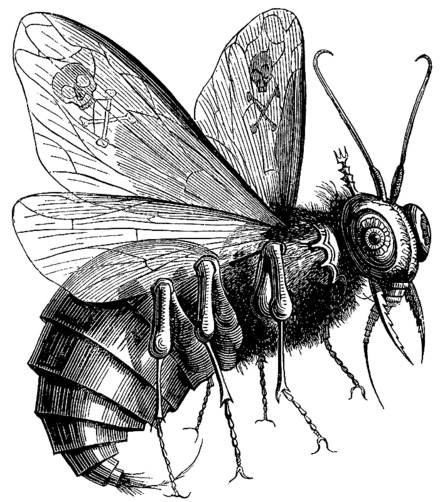
To this?

Let's talk about the history of Beelzebub!
Beelzebub is strongly associated and indeed often conflated with Baal, a Hellenistic era pagan god worshipped everywhere from the Canaanite city of Ekron to Greece (where he was known as Belus) to Egypt as far back as 1400 BCE. He is first mentioned in the Books of Kings (2 Kings 1:2–3, 6, 16) as Ba'al-zəbûb, meaning "Lord of the Flies" in Hebrew, a possible corruption of "Lord of the High Place" meant to denigrate the deity after he was appropriated and repurposed as a false god, then a demon. Baal worship was extremely difficult for the early Christians to stamp out, so they basically stole other people's mythology and used it as a free idea bucket to fill out the Bible's rogues gallery.
While it's true that in some Ugaritic texts, Baal is depicted as expelling flies and causing sickness, he was still held in high esteem in ancient Canaan and Phoenicia as a powerful deity who controlled the sun, storms, and fertility and who defeated Mot, the god of death and the underworld. The ancient world could get pretty scatological at times! After all, one of Beelzebub's contemporaries, the Egyptian sun god Ra, was often depicted as a dung beetle, then a prominent symbol of rebirth.
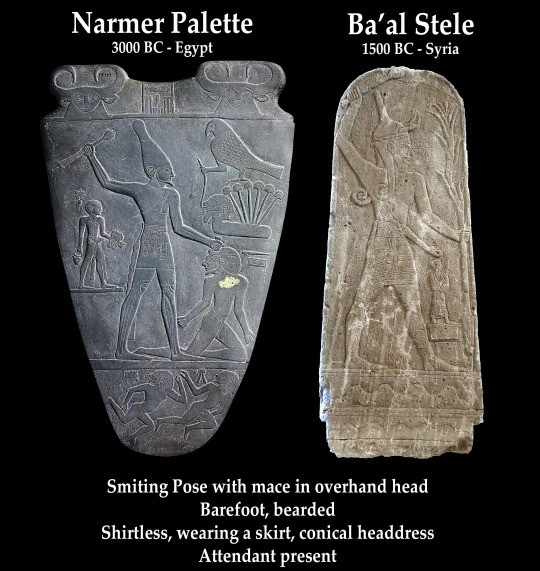
Some scholars think he might have even been the same god! Beelzebub seems to have been the ancient world's go-to demon because the name has been used interchangeably with everyone from Lucifer, Satan, and even Hades in some gnostic texts.
Unfortunately, we don't have much information about Beelzebub's pre-Christian origins other than some iron age ruins in what is now modern day Israel that suggest his temples were decorated with little golden flies, which is pretty neat.
Interestingly, Jesus himself was accused of being a worshipper of Beelzebub multiple times in the New Testament. Maybe the Pharisees were projecting?

Throughout the Middle Ages, Beelzebub reappeared again in the Lantern of the Light (where he was associated with the sin of envy), De Occulta Philosophia, Princes of Hell, and other demonology texts. 16th-17th Century French Inquisitor Sébastien Michaelis elevated him to the rank of fallen angel in his book The Admirable History of Possession and Conversion of a Penitent Woman: Seduced by a Magician that Made Her to Become a Witch, translated to English in 1613. It was around this time Beelzebub started to become strongly associated with witchcraft. Michaelis should know; he burnt over 14 women accused of being witches!
Unsurprisingly, his name came up repeatedly during the Salem witch trials.
Beelzebub and fellow demons new and old bounced all over different classifications of demons during the 1500s and 1600s. In John Milton's epic poem Paradise Lost, first published in 1667, Beelzebub was part of an unholy trinity consisting of him, Lucifer, and Astaroth. Occultist Johan Weyer decreed that Beelzebub was the Emperor of Hell, having led a successful revolt against the devil. German theologian Peter Binsfield described him as the Prince of Gluttony in his 1589 Treatise on Confessions by Evildoers and Witches. Before that, he was associated with Envy, then Pride.
We even have his personal signature! (At least according to the Grand Grimoir, an anonymous text on black magic of unknown origin)

Beelzebub's physical appearance is even more diverse. He's been depicted as everything from a leopard, a feminine man as tall as a tower, a snake, a calf with a fly's face to...whatever the literal hell this is:
"'dressed like a bee and with two dreadful ears and his hair painted in all colors with a dragon's tail"


Jacques Albin Simon Collin de Plancy (1793 – 1881)'s Dictionnaire infernal was among the first to depict Beelzebub literally as a fly. No duck feet, no lion's mane. Just a fly.
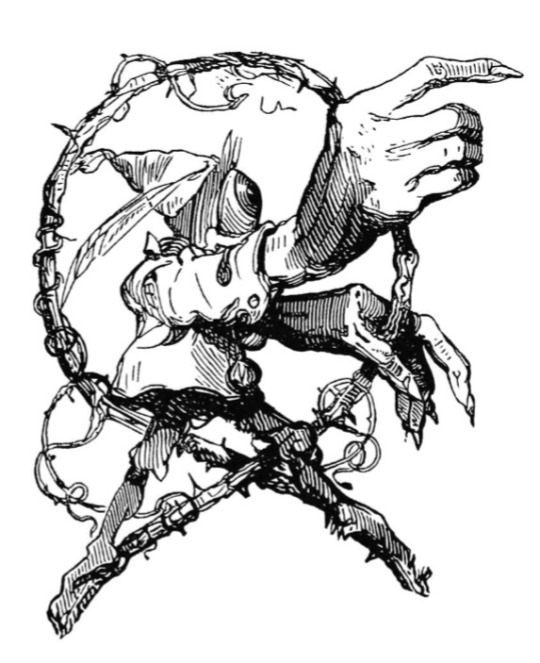
Still better than this.
As Plancy was a skeptic influenced by Voltaire, the book was first intended as a folklore compilation but was later modified to fit with Roman Catholic theology after he converted, much to the consternation of his admirers. Many of his lurid illustrations later appeared in S. L. MacGregor Mathers's edition of The Lesser Key of Solomon...for better or for worse.

Put Adrammelech in Helluva Boss you cowards.
So basically, Beelzebub has been a public domain character since before King Tut was laid in his golden sarcophagus, and people have been just making shit up about him for millennia. What's your favorite depictation of Beelzebub? This is mine:

Nothing beats 2nd Edition Dungeons & Dragons artwork.
#helluva boss#queen bee#beelzebub#character design#meta#demonology#history#mythology#long post#vivziepop#dandelion watches hellaverse#religion
36 notes
·
View notes
Note
Hi, sorry if this has been asked before, but do you have any reliable sources that talk about Ashtar? I'm also looking for articles that talk about El/Ilu; and Shalim and Shahar as well. I appreciate any form of help.
I've answered a similar Ashtar question a few months ago, refer to the bibliography here.
I do not have much to offer when it comes to Shahar and Shalim because as far as I can tell most scholarship focuses on exegesis of the Bible, which is something I have next to no interest in. I've answered a question about them here; the main source to depend on is Pardee's Ritual and Cult in Ugarit.
When it comes to El, the basic selection of sources dealing with Ugaritic religion should obviously be the start: Smith's Baal Cycle commentaries, Pardee's aforementioned book, Rahmouni's Divine Epithets in the Ugaritic Alphabetic Texts, Handbook of Ugaritic Studies, etc. For more specialized information I recommend:
a) Il in Personal Names by Alfonso Archi (early history, and why names with the element il and its cognates do not necessarily refer to a specific deity in pre-Ugaritic sources)
b) West Semitic god El in Anatolian Hieroglyphic Transmission by Ilya Yakubovich for the first millennium BCE
c) The God Eltara and the Theogony by Anna Maria Polvani for El's Hurro-Hittite career (there's also the Elkunirsa myth but I do not think there's any recent treatment of it, so your best bet is to just read the translation in Hoffner's Hittite Myths from the 1990s)
d) The Dwelling of ˀIlu in Baˁlu and ˀAqhatu by Madadh Richey for some lexical considerations regarding El's residence
e) God (Ilu) and King in KTU 1.23 by Theodore J. Lewis for El's role as the king of the gods
Also, it's worth checking out Wiggins' monograph A reassessment of Asherah: with further considerations of the goddess since while hardly focused on El, it does discuss Athirat's relationship with him in the Ugarit section. Similarly, might be worth looking into this author's Shapash article.
37 notes
·
View notes
Text
Hide in the light....

... hiding in darkness.
And Max even says it: opposite direction.
Darkness and Light.

Besides Max occasionally looks directly into the sunlight.
These images speak a similar but different language.

Note the walkie talkie next to Max's mirror image (It's a transmitter to speak to God. - El = Ugaritic deity later Hebrew for God)
Their dialogs...

... seem to tell the same tale yet they are not.
"As if the world would be different here" - "As if he was the problem"
"It was all a lie" - "It's never true"
"I could make my own rules" - "We make our own rules"
I'm not an English native speaker but the semantic differences between lies and "never true" are pretty obvious even to me:
He blames the world/his parents, she says her father wasn't to blame ; lies are deceptive, something that's not/never true can just be a misunderstanding (all lies are untrue but not everything that's untrue is a lie) ; he "could" make his own rules but alone = I (001} ; they just make their own rules together like in two Ones=0II).
Especially the last part is where we have mirrored shots, "Henry" looks at El from the left, Max from the right:
Could = used to talk about what someone or something was able or allowed to do or to express possibility and past tense.
Max's sentence is definite. (present tense, can be read as: always "We make our own rules" in past, present & future). Besides Max first says "almost" in regards to "never true". And it's to date the last sentence of her in the show.
These two are on the same level but on opposite ends of the spectrum.
Like in this image darkness and light are in the same shot, split into two sides of the frame and you have El & Max on one side and Vecna on the other.

Note that Brenner says Henry but in his explanation he says One. (Plus pronoun games between El and Owens.)
The lamp light creates like a halo or corona around Max's head in this promo shot (for S4 there's a god ray pointed at El... And I think at Will)

In the Phineas Gage scene we see her having like a beam of light or God ray directly on her head (it's a reflection of the glass behind her, a mirroring effect)

(again a male pronoun overlayed in the exact moment the camera changes focus to Max with Clarke saying his line - that is clearly connected to the scene in which El draws Max's face with her own it saying "This is Max", El being 5'6, Max living in No. 56 etc)
Btw...

I have a hunch what the green and red is alluding to. You may need special glasses. 😅
21 notes
·
View notes
Text

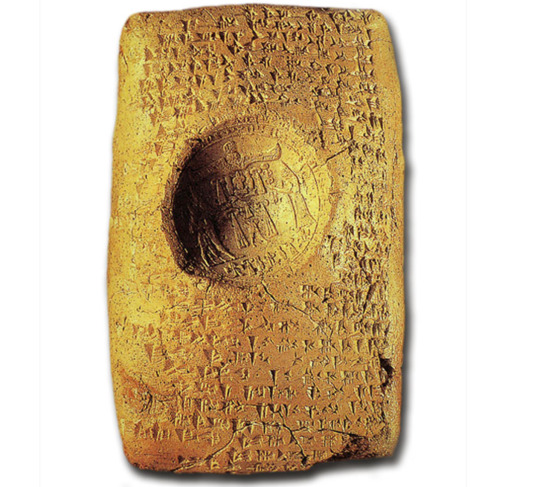
Divorce-Writ of King Ammistamru II
Ugarit, Syria
c. 1250 BCE
A tablet documenting the divorce of King Ammistamru II of Ugarit fromhattusa the daughter of the Amorite king Benteshina, sealed by the Hittite King Ammistamru. The king stands to the right, holding a spear, next to the "Weather God" who holds a club. They are both facing a long-robed female goddess (Arima, the chief Hittite sun-goddess) who stands at the left.
Source: Virtual Museum of Syria
#ugarit#hittite#baal#hadad#ugaritic costume#arima#sun goddess#huttusa#hittite gods#canaan#canaanite gods#phoenicia#phoenician gods#aram#aramean gods#syria#syrian gods#levantine gods#mesopotamia#mesopotamian gods#pagan gods#polytheism#archeology#magic#witchcraft#witchblr#paganblr#occult
267 notes
·
View notes
Text

Who is Levi?
Leviathan, Hebrew Livyatan, in Jewish mythology, a primordial sea serpent. Its source is in prebiblical Mesopotamian myth, especially that of the sea monster in the Ugaritic myth of Baal (see Yamm). In the Old Testament, Leviathan appears in Psalms 74:14 as a multiheaded sea serpent that is killed by God and given as food to the Hebrews in the wilderness. In Isaiah 27:1, Leviathan is a serpent and a symbol of Israel’s enemies, who will be slain by God. In Job 41, it is a sea monster and a symbol of God’s power of creation
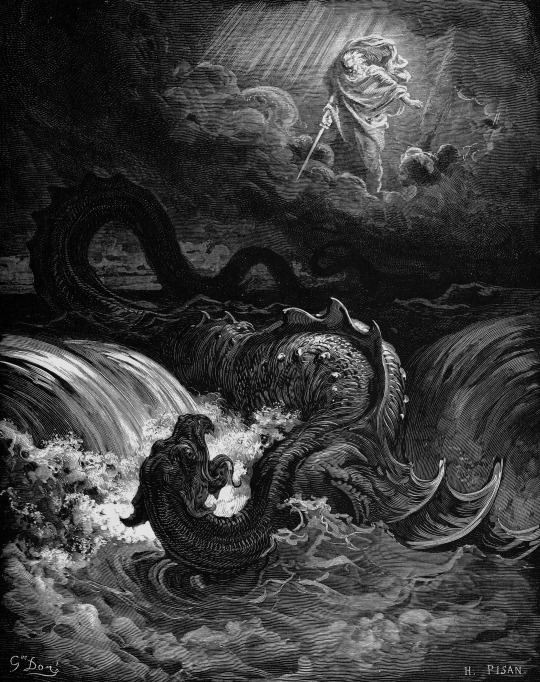
Etymology:
Gesenius (among others) argued the name לִוְיָתָןwas derived from the root לוה lwh "to twine; to join", with an adjectival suffix ן- ָ, for a literal meaning of "wreathed, twisted in folds". If it exists, the adjectival suffix ן- ָ (as opposed to -ון) is otherwise unattested except perhaps in Nehushtan, whose etymology is unknown; the ת would also require explanation, as Nechushtan is formed from neḥšoeṯ and Leviathan from liveyah; the normal-pattern f.s. adjective would be לויון, liveyon. Other philologists, including Leskien, thought it a foreign loanword. A third school considers it a proper noun. Bauer proposed לוית+תן, for "wreath of serpent."
Both the name and the mythological figure are a direct continuation of the Ugaritic sea monster Lôtān, one of the servants of the sea god Yammu defeated by Hadad in the Baal Cycle. The Ugaritic account has gaps, making it unclear whether some phrases describe him or other monsters at Yammu's disposal such as Tunannu (the biblical Tannin). Most scholars agree on describing Lôtān as "the fugitive serpent" (bṯn brḥ) ,but he may or may not be "the wriggling serpent" (bṯn ʿqltn) or "the mighty one with seven heads" (šlyṭ d.šbʿt rašm). His role seems to have been prefigured by the earlier serpent Têmtum whose death at the hands of Hadad is depicted in Syrian seals of the 18th–16th century BC.

Mythology:
Sea serpents feature prominently in the mythology of the ancient Near East. They are attested by the 3rd millennium BC in Sumerian iconography depicting the god Ninurtaovercoming a seven-headed serpent. It was common for Near Eastern religions to include a Chaoskampf: a cosmic battle between a sea monster representing the forces of chaos and a creator god or culture hero who imposes order by force. The Babylonian creation myth describes Marduk's defeat of the serpent goddess Tiamat, whose body was used to create the heavens and the earth.
—all art was found via Google, it doesn’t not belong to me, but to the artist who created it. If you see any art depicted on my channel that is yours and you do not want it shared, just tell me, I’m on your side ^_^-
#obey me#obey me shall we date#obey me leviathan#obey me!#obey me demonology#obey me origins#3rd husband
87 notes
·
View notes
Text
youtube
Baal, the powerful deity of the ancient Near East, has long been associated with the image of the bull. This majestic creature, with its strength and virility, embodies the essence of Baal and serves as a symbol of his divine power.
In the ancient Canaanite religion, Baal was worshipped as the god of storms, fertility, and agriculture. He was believed to control the rain and the growth of crops, making him a vital figure in the lives of the people. As such, the image of the bull became closely linked to Baal, representing his ability to bring abundance and prosperity to the land.
One of the most famous depictions of Baal as a bull can be found in the Ugaritic texts, a collection of ancient clay tablets discovered in modern-day Syria. In these texts, Baal is described as a mighty bull, with thunderbolts in his horns and a voice that shakes the earth. He is often depicted as a fierce warrior, battling against the forces of chaos and ensuring the fertility of the land.
The bull was also a common motif in the temples dedicated to Baal. These magnificent structures, adorned with intricate carvings and paintings, were built to honor the deity and serve as a place for his worshippers to offer sacrifices and prayers. The image of the bull could be found in various forms throughout these temples, from statues and reliefs to decorative motifs on the walls and pillars.
But the significance of the bull in Baal worship goes beyond its representation in art and architecture. In many ancient rituals, bulls were sacrificed to appease Baal and ensure his favor. The blood of the bull was seen as a powerful offering to the deity, symbolizing the renewal of life and the continuation of the agricultural cycle.
The association between Baal and the bull also extends to other cultures and religions. In Greek mythology, the god Zeus is often depicted as a bull, and some scholars believe that this may have been influenced by the worship of Baal in the ancient Near East. Similarly, the biblical figure of the golden calf, worshipped by the Israelites during their journey in the desert, has been linked to the cult of Baal.
Today, the image of the bull continues to be associated with Baal, serving as a reminder of his enduring power and influence. It is a symbol of fertility, strength, and abundance, representing the divine forces that govern the natural world. And while the worship of Baal may have supposedly faded into history, the image of the bull remains a powerful reminder of the enduring legacy of this ancient deity.
#occult#witchblr#witchcraft#satanism#baneful magic#witch#witches#hail satan#ars goetia#bible#christians#christianity#christian#Youtube
14 notes
·
View notes
Note
Hi! I came across your beautiful art of Canaanite gods, and I wondered if you are making art solely based on the mythology or if you have some story/universe of your own. I hope this question makes sense. Have a nice day.
Hi!!
Most of my art on the Baal Cycle is based directly on the texts that we have access to. HOWEVER! The texts we have access to such as the Baal Cycle and the Epic of Aqhat are fragmentary with large parts missing and unfortunately do not go into much detail in the intact parts. To make it more frustrating there is an academic discourse on different translations of the Ugaritic texts (example: Anat has an epithet that translates to 'virgin', but different translations equate 'virgin' to either 'unmarried' or 'prepubescent/young girl') and depending on which translation you heed you can come away with different ideas (irt previous example: Anat is either an unmarried adult woman connected with sexual fertility or a prepubescent child associated with sexual fertility, which can get real gross (you can guess which translation/iteration i prefer)).
So, long way for me to say: ... kind of both!
It's all very HEAVILY based on the texts, BUT I do have to make up quite a lot as I go, especially physical attributes of various characters, the locations of their palaces/thrones (I made up Mot's palace being a salt pillar in the Dead Sea because it makes thematic sense), relationships between characters (It's debated who exactly Baal's wife is, if he has one wife, if the wife is Astarte or Anat, who Anat's mother is, how many wives El has), etc. etc. etc.
The bones and overarching narrative are taken directly from the mythology, but because of whatever myriad of circumstances the oral traditions and written mythologies haven't survived enough to create a framework for me to actually stick to without skipping over VERY important things, like: How did Baal die? Which is incredibly central. Also, irt the Baal Cycle and the tablets that its written on, we Don't Know which tablets go in which order so I kinda gotta play it by ear with which events go before which.
Sorry for the long explanation! I try my best to note which aspects of the Canaanite myth stuff I do is entirely my own creative liberty or conjecture, mostly because 1. I don't want to misrepresent the texts, and 2. I highly encourage people to read translations of the texts themselves, if they are able (unfortunately it's written in very stilted language, so I completely get why it'd be eye roll inducing for many).
PS: I have a personal vendetta against Illimilku of Ugarit, who was the scribe that wrote down the only written iterations of the Baal Cycle and Epic of Aqhat, that we know of. Why didn't he make more??? I need to know how the EoA ends!!! Here's a shitty meme I made about my frustration.

12 notes
·
View notes
Text
Can we just let the Greeks have their gods? Why are people so obsessed with origins proving The Theoi Aren't Actually Greek™. I don't see anyone saying "well Hindu deities aren't actually Hindu, they're not from India! They're from the Proto-Indo-Europeans so aCkTUalY they're Eurasian Gods not from the Indian Subcontinent." Seems Hellenic Polytheist/Pagan spaces are hellbent on allowing Greeks to only claim deities whose origin is in the Mycenaean Pantheon. Otherwise they aren't actually Greek they're Minoan, Hittite, Phoenician, Egyptian, general ""ANE"", Etruscan (I guess), etc— then again even the Mycenaeans are robbed of autonomy because thats just a PIE pantheon like the Hittites. It's ridiculous.
Tracing the origin of deities is pretty awesome, but when you deny a culture its deities just because you can trace their worship back in history you're plainly being disrespectful. For example, Ašratu is a chief deity of the Amorite tribe, which came to rule Babylon. Thus their Goddess became apart of the "Babylonian Pantheon" as the Daughter in Law of An. Athirat an important Ugaritic (Canaanite) deity undoubtedly shares her origin with this Amorite deity, and became a principal Goddess in the "Ugaritic/ Canaanite Pantheon". Does that mean Ašratu isn't actually Babylonian and therefore (pretending they still existed) Babylonians can't lay claim to her as part of their heritage, culture, and pantheon? Or that Athirat isn't actually Canaanite therefore (if they still existed) Canaanites can't lay claim to her as part of their heritage, culture, and pantheon? No. That makes no fucking sense— Ašratu is Babylonian & Athirat is Canaanite even if the deities have their "origins" with the semi-nomadic Amorite culture.
Since Mesopotamian Ašratu was understood to be an Amorite deity, a connection between Ašratu’s and Athirat’s origins appears to be virtually certain. Being transferred to a different culture would have led to some adaptation of the Goddess to her new culture. This should stand as a caution not to apply specific details of Ašratu’s characteristics developed in Mesopotamia to Athirat simply because the earliest records attest to the former.” [X]
The same principles goes for the Greek Gods, just because a Theos' origin, for example Zeus, can be traced back to an earlier culture—*Dyḗus from the PIE people of the Pontic-Caspian Steppe—doesn't make Zeus any less of a GREEK deity.
This "they aren't Greek" trend is strongest with Aphrodite— whose worship probably "began" somewhere in the Ancient Near East primarily Cyprus or Phoenicia. The trend is also present and increasing with Apollo who has multiple different possible "origins."
If you're so obsessed with determining that none of the Greek Gods are actually Greek pick a different tradition to worship them in. Stop using "Hellenic" and say you're a PIE polytheist or Phoenician Polytheist or whatever tradition the """original version"""" of the Theos you are worshipping comes from. If you want to be a Hellenic Polytheist don't try and negate the Theoi's Greekness. Its bafflingly disrespectful especially since Greeks still exist and this is still their heritage.
No this isn't a "folkish" post its a salty post. And it is not directed at any one person but a phenomenon that pops up and seems to be increasing and I'm annoyed with it.
-not audio proof read-
[Edit, no I'm not talking about people who use 'Greek names' in Greco-Roman, Greco-Egyptian or any other syncretic traditions. I'm specifically talking about Hellenic Polytheist/Pagans who are obsessed with the Greek Gods being non-Greek because "origins"]
103 notes
·
View notes